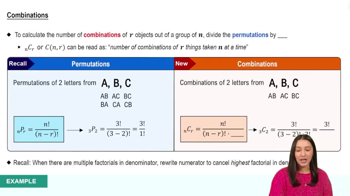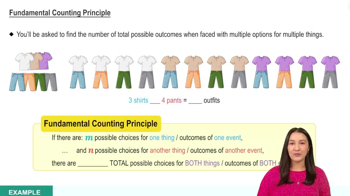DNA Nucleotides DNA (deoxyribonucleic acid) is made of nucleotides. Each nucleotide can contain any one of these nitrogenous bases: A (adenine), G (guanine), C (cytosine), T (thymine). If one of those four bases (A, G, C, T) must be selected three times to form a linear triplet, how many different triplets are possible? All four bases can be selected for each of the three components of the triplet.
Table of contents
- 1. Intro to Stats and Collecting Data1h 14m
- 2. Describing Data with Tables and Graphs1h 55m
- 3. Describing Data Numerically2h 5m
- 4. Probability2h 16m
- 5. Binomial Distribution & Discrete Random Variables3h 6m
- 6. Normal Distribution and Continuous Random Variables2h 11m
- 7. Sampling Distributions & Confidence Intervals: Mean3h 23m
- Sampling Distribution of the Sample Mean and Central Limit Theorem19m
- Distribution of Sample Mean - Excel23m
- Introduction to Confidence Intervals15m
- Confidence Intervals for Population Mean1h 18m
- Determining the Minimum Sample Size Required12m
- Finding Probabilities and T Critical Values - Excel28m
- Confidence Intervals for Population Means - Excel25m
- 8. Sampling Distributions & Confidence Intervals: Proportion1h 12m
- 9. Hypothesis Testing for One Sample3h 29m
- 10. Hypothesis Testing for Two Samples4h 50m
- Two Proportions1h 13m
- Two Proportions Hypothesis Test - Excel28m
- Two Means - Unknown, Unequal Variance1h 3m
- Two Means - Unknown Variances Hypothesis Test - Excel12m
- Two Means - Unknown, Equal Variance15m
- Two Means - Unknown, Equal Variances Hypothesis Test - Excel9m
- Two Means - Known Variance12m
- Two Means - Sigma Known Hypothesis Test - Excel21m
- Two Means - Matched Pairs (Dependent Samples)42m
- Matched Pairs Hypothesis Test - Excel12m
- 11. Correlation1h 6m
- 12. Regression1h 50m
- 13. Chi-Square Tests & Goodness of Fit1h 57m
- 14. ANOVA1h 57m
4. Probability
Counting
Problem 4.4.23b
Textbook Question
Corporate Officers and Committees The Self Driving Unicycle Company was recently successfully funded via Kickstarter and must now appoint a president, chief executive officer (CEO), chief operating officer (COO), and chief financial officer (CFO), and chief human resources officer (CHR). It must also appoint a strategic planning committee with five different members. There are 15 qualified candidates, and officers can also serve on the committee.
b. How many different ways can a committee of five be appointed?
 Verified step by step guidance
Verified step by step guidance1
Step 1: Recognize that the problem involves selecting a committee of 5 members from a pool of 15 candidates. Since the order of selection does not matter, this is a combination problem.
Step 2: Recall the formula for combinations, which is given by: , where is the total number of candidates and is the number of members to be selected.
Step 3: Substitute the values into the formula. Here, and . The formula becomes: .
Step 4: Simplify the factorials. Compute , , and . Then simplify the fraction by canceling out common terms in the numerator and denominator.
Step 5: Perform the division to find the total number of combinations. This will give the total number of ways to select a committee of 5 members from 15 candidates.
 Verified video answer for a similar problem:
Verified video answer for a similar problem:This video solution was recommended by our tutors as helpful for the problem above
Video duration:
2mPlay a video:
Was this helpful?
Key Concepts
Here are the essential concepts you must grasp in order to answer the question correctly.
Combinations
Combinations refer to the selection of items from a larger set where the order does not matter. In this scenario, we need to choose 5 members from 15 candidates, which is a classic example of a combination problem. The formula for combinations is given by C(n, k) = n! / (k!(n-k)!), where n is the total number of items, k is the number of items to choose, and '!' denotes factorial.
Recommended video:

Combinations
Factorial
Factorial is a mathematical operation that multiplies a number by all positive integers less than it. It is denoted by n! and is essential in calculating combinations and permutations. For example, 5! equals 5 × 4 × 3 × 2 × 1 = 120. Understanding factorials is crucial for solving problems involving arrangements and selections in statistics.
Recommended video:

Combinations
Counting Principles
Counting principles are fundamental rules used to determine the number of ways to arrange or select items. In this context, the combination formula is applied to count the different ways to form a committee from a pool of candidates. Mastery of counting principles allows for efficient problem-solving in various statistical scenarios, especially when dealing with large sets of data.
Recommended video:

Fundamental Counting Principle

 7:11m
7:11mWatch next
Master Introduction to Permutations with a bite sized video explanation from Patrick
Start learningRelated Videos
Related Practice
Textbook Question
